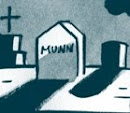Little Monsters

Super-monsters
Superheroes and monsters have quite a bit in common. They both seem to inhabit similar worlds filled with mad scientists and invading aliens and they are both often victims of scientific experiments gone wrong. Even though they are natural enemies, superheroes and monsters tend to solve problems with more brawn than brains, and they have hard times getting dates.
There is one type of superhero, however, that combines the ugliness of monsters with the heroics of heroes: the monster turned hero. Quite rare, famous monsters-turned-heroes include versions of Frankenstein's monster, Dracula (Dell Comics) and other vampires (Morbius), werewolves (Werewolf by Night), not to mention all the assorted swamp creatures and robots. Cartoonist Jack Kirby created some of the most famous, including The Hulk, The Thing, and the philosophic Karkas (from The Eternals). But even these classic creations pale in comparison to Spider and Web, the superheroic alter egos of Gold Key's Little Monsters.
The Little Monsters were created for Gold Key most likely to cash in on the 1960s monster craze without having to pay licensing fees to big-name properties. Legendary editor Chase Craig was probably the man responsible. According to writer Mark Evanier, Craig was an idea man and scripter responsible for many of the little nuggets of the Gold Key universe, including Magnus, Robot Fighter and Mary Jane and Sniffles.
The Little Monsters debuted as a back-up in The Three Stooges comic in 1964 and graduated to their own title later that year. The title characters are two tiny flat-headed, bolt-necked horrors named 'Orrible Orvie and Awful Annie. Their parents also resemble Frankenstein's monster and the whole family live in a run-down mansion full of goofy horror-movie props, just like the Addams Family or the Munsters. Dad Mildew is a typical sitcom-style oaf who doesn't know his own strength and is often helped out of a fix by his slightly smarter children. Mom Demonica is a hatchet-faced, top-knot-wearing housewife in the Wilma Flintstone mold.
The series was suspended as the monster craze waned but was brought back in the early 70s for a brief revival which may have been intitiated to use up some left-over stories. This seems to be the case with Little Monsters #19 from November 1972, featuring "The Return of the Spider."
This story begins with Orvie and his sister Annie watching their favourite TV show, "Fatman and Slobin" --an obvious parody of the 1960s Batman show starring Adam West and Burt Ward, with all the sound effects intact. The kids are inspired by the show and are given a source of inspiration for their own costumes when "a bolt of lightning illuminates an eerie shadow on the living room window." The giant spider they see resembles the bat that Bruce Wayne sees fly through his window in Bob Kane and Bill Finger's Batman origin story from the 1930s.

Annie and Orive dig up their old Halloween costumes, with spider and web insignias, masks and capes, and decide to "roam the night" while the narrative caption reads: "Thus was born the Gruesome Twosome, those fearsome, fearful, fighters of crime ...Spider and Web!" When they tell their folks about their new identities, Demonica tells them it's getting late and sends them to bed!
Next morning, back in front of the TV, the Gruesome Twosome hear that The Hoaxer, a "notorious criminal," is heading for their town and planning a crime spree. Suiting up, Spider and Web hop on their broomstick and go flying out over the town in search of the villain and his gang. After the Hoaxer steals and entire bank, the pair trace him to his lair on top of the Ritz Hotel and use a few Batman-like tricks to get in, including the tossing of a "spider-hook" and walking up the side of the building. After their web breaks, they decide to just fly up on their broom, whereupon they are easily captured by the adult gang and thrown into a hall of mirrors.

After smashing out, the brats are easily captured again and literally hoisted with their own petard when they are suspended by spider web over the edge of the building, only to be saved in the nick of time by a trio of monstrous superheroes led by their own superstrong father. Safe at home, the kids are in for one final scare when their parents find a giant caped spider to replace them as town superhero!

The art chores on Little Monsters were most likely by either Pete Alvarado or Phil DeLara, the workhorses of Dell and Gold Key funny animal and animation-related comics. Both had extensive experience in animation and kept one foot in the Hollywood animation studios and the other in the world of comics and strips, churning out thousands of pages of humour comics in a clean, emotive style, although without a lot of variety in terms of linework. Some of the character designs in the comic are pretty clunky and sometimes the figures seem to lack weight or dimension. Both Mark Evanier and Scott Shaw have identified the artist on this story as John Carey, a cartoonist closely identified with Woody Woodpecker comics.
The writer on the series (none of the stories are credited) could have been Craig or may have been another workhorse like Vic Lockman, a writer and cartoonist who now specializes in religious comics. Either way, the script in "The Return of the Spider" is full of knowing references to superhero comics and manages to be both amusing and well-plotted. A perfect Halloween treat for the superhero monster (or monster-superhero) fan!
Thanks to Mark Evanier.


